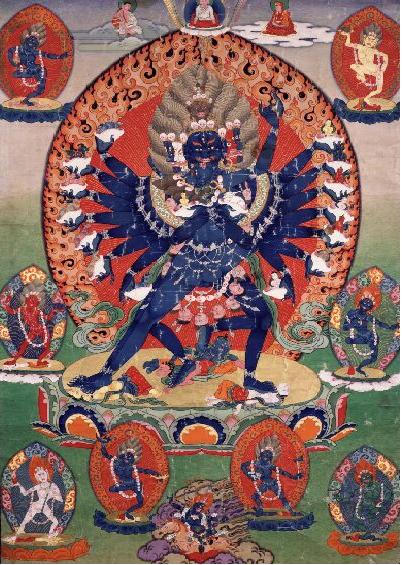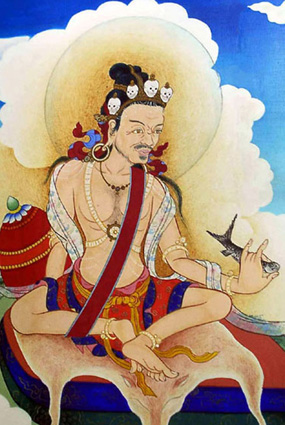|
Hevajra
Hevajra ( Tibetan: kye'i rdo rje / kye rdo rje; Chinese: 喜金剛 Xǐ jīngāng / 呼金剛 Hū jīngāng;) is one of the main yidams (enlightened beings) in Tantric, or Vajrayana Buddhism. Hevajra's consort is Nairātmyā ( Tibetan: bdag med ma). History India The Hevajra Tantra, a ''yoginītantra'' of the '' anuttarayogatantra'' class, is believed to have originated between the late 8th (Snellgrove), and the late 9th or early 10th (Davidson), centuries in eastern India, possibly Kamarupa. Tāranātha lists Saroruha and Kampala (also known as Lva-va-pā, Kambhalī, and Śrī-prabhada") as its "bringers": . . . the foremost yogi Virupa meditated on the path of Yamāri and attained siddhi under the blessings of Vajravārāhi, . . . His disciple Dombi Heruka..understood the essence of the Hevajra Tantra, and composed many śāstras like the ''Nairātmā-devi-sādhana'' and the ''Sahaja-siddhi''. He also conferred abhiṣeka on his own disciples. After this, two ācār ... [...More Info...] [...Related Items...] OR: [Wikipedia] [Google] [Baidu] |
Vajrayana
''Vajrayāna'' (; 'vajra vehicle'), also known as Mantrayāna ('mantra vehicle'), Guhyamantrayāna ('secret mantra vehicle'), Tantrayāna ('tantra vehicle'), Tantric Buddhism, and Esoteric Buddhism, is a Mahāyāna Buddhism, Mahāyāna Buddhist tradition that emphasizes Eastern esotericism, esoteric practices and rituals aimed at Sudden awakening, rapid spiritual awakening. Emerging between the 5th and 7th centuries CE in medieval India, Vajrayāna incorporates a Tibetan tantric practice, range of techniques, including the use of mantras (sacred sounds), dhāraṇīs (mnemonic codes), mudrās (symbolic hand gestures), mandalas (spiritual diagrams), and the visualization of Buddhist deities, deities and Buddhahood, Buddhas. These practices are designed to transform ordinary experiences into paths toward Enlightenment in Buddhism, enlightenment, often by engaging with aspects of Taṇhā, desire and Dvesha, aversion in a ritualized context. A distinctive feature of Vajrayāna is ... [...More Info...] [...Related Items...] OR: [Wikipedia] [Google] [Baidu] |
Anuttarayogatantra
Classes of Tantra in Tibetan Buddhism refers to the categorization of Buddhist tantric scriptures in Indo-Tibetan Buddhism. Tibetan Buddhism inherited numerous tantras and forms of tantric practice from medieval Indian Buddhist Tantra. There were various ways of categorizing these tantras in India. In Tibet, the Sarma (New Translation) schools categorize tantric scriptures into four classes, while the Nyingma (Ancients) school use six classes of tantra. Sarma ("New Translation") classification The Sarma, "New Translation" schools of Tibetan Buddhism (Gelug, Sakya, Kagyu, Jonang) classify tantric practices and texts into four classes. In this, they follow Indian Tantric Buddhists such as Abhayākara, who makes this distinction in his ''Clusters of Quintessential Instructions''. Tantras are classified according to the capacity of persons, the deities they use, the specific types of methods they employ and how they use desire (''kama'').Tsong-kha-pa, ''The Great Exposition of ... [...More Info...] [...Related Items...] OR: [Wikipedia] [Google] [Baidu] |
Kampala (Lawapa)
Lawapa or Lavapa () was a figure in Tibetan Buddhism who flourished in the 10th century. He was also known as Kambala and Kambalapada (Sanskrit: ). Lawapa, was a mahasiddha, or accomplished yogi, who travelled to Tsari. Lawapa was a progenitor of the Dream Yoga sādhanā and it was from Lawapa that the mahasiddha Tilopa received the Dream Yoga practice lineage. Bhattacharya, while discussing ancient Bengali literature, proffers that Lawapa composed the '' Kambalagītika'' ( "Lawapa's Song") and a few songs of realization in the ''Charyapada''. Simmer-Brown (2001: p. 57) when conveying the ambiguity of ḍākinīs in their "worldly" and "wisdom" guises conveys a detailed narrative that provides the origin of Lawapa's name: Nomenclature, orthography and etymology Alternate English orthographies are Lwabapa, Lawapa and Lvapa. Simmer-Brown, Judith (2001). ''Dakini's Warm Breath: the Feminine Principle in Tibetan Buddhism''. Boston, USA: Shambhala. (alk. paper): p. 57; p. 31 ... [...More Info...] [...Related Items...] OR: [Wikipedia] [Google] [Baidu] |
Dombi Heruka
Dombi Heruka (8th-9th century CE, Sanskrit: , ), also known as Dombipa (Sanskrit: , ) and by his epithet Tiger-Rider, is one of the eighty-four mahasiddhas ('great adept') venerated in Vajrayana Buddhism. In paintings and sculptures, he is depicted seated on a tiger, with a snake in his hand, sometimes in union with his consort. Dombi Heruka is described as king of Magadha or Tripura; or at least a Brahmin son of a local chieftain. His legends and name emphasize his relationship with an outcaste spiritual consort, which was taboo. He is associated with Tantric rituals related to the deity Hevajra. A few works including '' Shri-sahaja-siddhi'' are attributed to Dombi Heruka. Various lama lineages like the Gelugpa Longdol Lama, Trungpa tulkus and Tai Situpa lamas claim to be incarnations of Dombi Heruka. Names and dating Dombi Heruka is an amalgamation of two terms - ''dombi'' and ''heruka''. '' Dombi'' refers to an "untouchable" nomadic artist caste, to which the mahasiddha ... [...More Info...] [...Related Items...] OR: [Wikipedia] [Google] [Baidu] |
Nairatmya
Nairātmyā or Dagmema () is a Dakini, the consort of Hevajra in the Hevajra-tantra. Her name means "ego-less woman". References See also * Nairatmya - Concept in Buddhism * Sitatapatra *Narodakini *Saraswati *Queen Maya * Hariti *Yakshini *Prithvi *Vajrayogini *Tara (Buddhism) Tara (, ; , ), Ārya Tārā (Noble Tara), also known as Jetsün Dölma (Tibetan: ''rje btsun sgrol ma,'' meaning: "Venerable Mother of Liberation"), is an important female Buddha in Buddhism, especially revered in Vajrayana Buddhism and Mahayan ... {{Buddhism topics Buddhas Dakinis Female buddhas and supernatural beings te:నైరాత్మ్యా ... [...More Info...] [...Related Items...] OR: [Wikipedia] [Google] [Baidu] |
Tantra
Tantra (; ) is an esoteric yogic tradition that developed on the India, Indian subcontinent beginning in the middle of the 1st millennium CE, first within Shaivism and later in Buddhism. The term ''tantra'', in the Greater India, Indian traditions, also means any systematic broadly applicable "text, theory, system, method, instrument, technique or practice". A key feature of these traditions is the use of mantras, and thus they are commonly referred to as Mantramārga ("Path of Mantra") in Hinduism or Mantrayāna ("Mantra Vehicle") and Guhyamantra ("Secret Mantra") in Buddhism. In Buddhism, the Vajrayana traditions are known for tantric ideas and practices, which are based on Indian Tantras (Buddhism), Buddhist Tantras. They include Tibetan Buddhism, Indo-Tibetan Buddhism, Chinese Esoteric Buddhism, Japanese Shingon Buddhism and Nepalese Newar Buddhism. Although Southern Esoteric Buddhism does not directly reference the tantras, its practices and ideas parallel them. In Bud ... [...More Info...] [...Related Items...] OR: [Wikipedia] [Google] [Baidu] |
Yidam
A ''yidam'' or ''iṣṭadevatā'' is a meditational deity that serves as a focus for meditation and spiritual practice, said to be manifestations of Buddhahood or enlightened mind. Yidams are an integral part of Vajrayana, including Tibetan Buddhism, Chinese Esoteric Buddhism and Shingon, which emphasize the use of esoteric practices and rituals to attain enlightenment more swiftly. The yidam is one of the three roots of the inner refuge formula and is also the key element of deity yoga. Yidam is sometimes translated by the term "tutelary deity". A yidam is considered to be a manifestation of enlightened qualities and a means to connect with specific aspects of the enlightened mind. The yidam is visualized during meditation in intricate detail, with the aim of internalizing its qualities and attributes. This practice is intended to facilitate the practitioner's transformation and realization of their own innate enlightened nature. It is believed to help purify the mind, ... [...More Info...] [...Related Items...] OR: [Wikipedia] [Google] [Baidu] |
Sakya (tribe)
Shakya (Pāḷi: ; Sanskrit: ) was an ancient Indo-Aryan clan of the northeastern region of South Asia, whose existence is attested during the Iron Age. The Shakyas were organised into a (an aristocratic oligarchic republic), also known as the Shakya Republic. The Shakyas were on the periphery, both geographically and culturally, of the eastern Indo-Gangetic Plain in the Greater Magadha cultural region. Location The Shakyas lived in the Terai – an area south of the foothills of the Himalayas and north of the Indo-Gangetic Plain with their neighbors to the west and south being the kingdom of Kosala, their neighbors to the east across the Rohni River being the related Koliya tribe, while on the northeast they bordered on the Mallakas of Kushinagar. To the north, the territory of the Shakyas stretched into the Himalayas until the forested regions of the mountains, which formed their northern border. The capital of the Shakyas was the city of Kapilavastu. Etymology The n ... [...More Info...] [...Related Items...] OR: [Wikipedia] [Google] [Baidu] |
Trikaya
The Trikāya (, lit. "three bodies"; , ) is a fundamental Buddhist doctrine that explains the multidimensional nature of Buddhahood. As such, the Trikāya is the basic theory of Mahayana Buddhist theology of Buddhahood. This concept posits that a Buddha has three distinct ''kayas'' or "bodies", aspects, or ways of being, each representing a different facet or embodiment of Buddhahood and ultimate reality. The three are the '' Dharmakāya'' (Sanskrit; Dharma body, the ultimate reality, the Buddha nature of all things), the ''Sambhogakāya'' (the body of self-enjoyment, a blissful divine body with infinite forms and powers) and the '' Nirmāṇakāya'' (manifestation body, the body which appears in the everyday world and presents the semblance of a human body). It is widely accepted in Buddhism that these three bodies are not separate realities, but functions, modes or "fluctuations" (Sanskrit: vṛṭṭis) of a single state of Buddhahood. The Trikāya doctrine explains how a Bu ... [...More Info...] [...Related Items...] OR: [Wikipedia] [Google] [Baidu] |
Tilopa
Tilopa (Prakrit; Sanskrit: Talika or Tilopadā; 988–1069) was an Indian Buddhist tantric mahasiddha who lived along the Ganges River. He practised Anuttarayoga Tantra, a set of spiritual practices intended to accelerate the process of attaining Buddhahood. He became a holder of all the tantric lineages, possibly the only person in his day to do so. In addition to the way of insight and Mahamudra, Tilopa learned and passed on the Way of Methods (today known as the Six Dharmas of Naropa, Six Yogas of Naropa) and guru yoga. Naropa is considered his main student. Life Tilopa was born into the priestly Brahmin caste of Bengalis, Bengali origin in Eastern India. He adopted the monastery, monastic life upon receiving orders from a dakini (female buddha whose activity is to inspire practitioners) who told him to adopt a mendicant and itinerant minister, itinerant existence. From the beginning, she made it clear to Tilopa that his real parents were not the persons who had raised him bu ... [...More Info...] [...Related Items...] OR: [Wikipedia] [Google] [Baidu] |
Naropa
Nāropā (Prakrit; , Naḍapāda or Abhayakirti) was an Indian Buddhism, Buddhist Mahasiddha. He was the disciple of Tilopa and brother, or some sources say partner and pupil, of Niguma. As an Indian Mahasiddha, Naropa's instructions inform Vajrayana, particularly his six yogas of Naropa relevant to the completion stage of anuttarayogatantra. He was also one of the "gatekeepers" of Vikramashila monastery which is located in Bihar. Although some accounts relate that Naropa was the personal teacher of Marpa Lotsawa, other accounts suggest that Marpa held Naropa's lineage through intermediary disciples only. Names According to scholar John Newman, "the Tibetans give Nāro's name as ''Nā ro pa, Nā ro paṇ chen, Nā ro ta pa,'' and so forth. The manuscript of the ''Paramarthasaṃgraha'' preserves a Sanskrit form ''Naḍapāda'' (''Paramarthasaṃgraha'' 74). A Sanskrit manuscript edited by Tucci preserves an apparent Prakrit form ''Nāropā'', as well as a semi-Sanskritic '' ... [...More Info...] [...Related Items...] OR: [Wikipedia] [Google] [Baidu] |











